Iirc (and I Don't Have A Source Handy For This At The Moment), In Medieval Europe Wheat Was Primarily
iirc (and I don't have a source handy for this at the moment), in medieval Europe wheat was primarily consumed by the middle and upper classes (which would probably have included anyone writing a bestiary!), whereas barley (and rye) were primarily what peasants used to bake their bread (in addition to being food for livestock, and of course, brewing beer!). Little bit of a class bias from the writer, perhaps?
As an aside, I suspect that the Venn diagram of tumblr users who are interested in drawing weird animals, and tumblr users who know about extant (or extinct) weird animals is going to be pretty close to a perfect circle!
Honestly, at this stage I'm finding that half the challenge - and don't get me wrong, very much half the fun too - is interpreting the prompts in a way that tries not to deliberately reference what I think the creature is. In some cases, I've got a pretty good idea, but in others, no freaking idea at all... It's interesting in those latter ones to see how close I actually got :D
I’m glad we got this prompt, despite it being pretty obvious, since I feel we all had a lot if fun with this one!
Bestiaryposting Results: Kengliwa
So, as it seems everyone made note of, this week's creature was exceptionally easy to guess. (To the point that a couple people did actually go ahead and name it, which I can't be that annoyed about because I don't think anyone missed this one.) I actually thought about not including it -- I cut a few that were particularly obvious like this one, but this entry was just so beautifully written that I didn't want to not post it. Maybe I should have done a separate post like with the dogs... live and learn, I suppose.
Anyway, previous entries and results can be found here: https://maniculum.tumblr.com/bestiaryposting. And the entry everybody is working from is at the link below:
Art below the cut in rough chronological order, as per usual.

@sweetlyfez (link to post here) decided to go a bit Beatrix Potter, and produced some frankly adorable shrew-like critters. (And her own alt-text, thank you.) They're dressed in these nice black coats and bowler hats so they can look like the "black column across the fields" described in the entry. I love everything about this. Also, if you want to see a version of this without the linework, check the link above.

@silverhart-makes-art (link to post here) decided to work off of the assertion that Kengliwas prefer wheat to barley because "barley is food for beasts". Naturally this means the Kengliwa must not itself be a beast, and Silverhart reflects that by medieval definition that excludes pretty much everything but birds and fish. So here we have a very small mouse-bird (the results of this one are all very cute, I have to say). And of course it's a flightless bird, because the entry describes them as walking. I'm really struck by the general composition of this one; the tiny bird clinging to the top of a wheat stalk is so well depicted. The colors are great too.

@cheapsweets (link to post here) followed the same "not a beast" logic as Silverhart, though they also name "serpent" and "worm" as potential non-beast categories. They also picked "bird", because the Kengliwa brings grain back to its nest, and birds have nests, so there you go. I appreciate that they've continued with that connection by having the interior of the Kengliwa burrow lined in a manner reminiscent of birds' nests. (And also that they provided alt-text, thank you.) Speaking of which, check it out, burrowing birds! With a cross-section of their burrow! Delightful. They further speculate that the symbolism attached to this one must be pretty weird given the mixed feelings the author seems to have, so I went and checked...
... there's actually not a lot of symbolism on this one. The highlights are that the divided grain supply represents the division between the Old and New Testaments, and barley represents heresy which is why it is scorned. (Pretty sure lots of people in the Middle Ages ate barley, but I suppose they preferred wheat.) The symbolism is all "things we learn from the good example of this industrious creature", and the entry quotes Proverbs 6:6 -- I'm not copying it here, because even though I'm pretty sure everyone knows what the animal is, the verse in question does name it, and we have a procedure here.
Anyway, as always, I recommend clicking on the link to CheapSweets's post to see their detailed explanation of their design decisions.

@theforceisstronginthegirl (link to post here) has drawn some ants in their agenda book. I have to admit, I'm not fully sure whether this was meant to be an entry, but you know, there's a picture (with alt-text and everything!) and it's tagged "kengliwa", so in it goes. Honestly I think the highlight here is that they described the creatures in the picture as "scribbles with jobs" which I think is a fun way to describe bugs generally. Very dynamically drawn scribbles too; they're quite expressive.
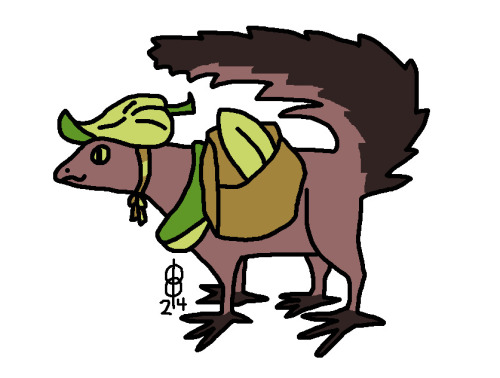
@pomrania (link to post here) has drawn a strange and adorable critter. It's giving... lizard-squirrel. Squizard. Particularly delighted by the fact that multiple people decided that such an industrious fellow should be wearing tiny clothing. I think the bag with one (1) grain of wheat in it is a nice touch. You just want to root for this little guy, you know? Also it's worth checking out Pomrania's linked post and associated progress post for some interesting steps in the design process for this one.

@coolest-capybara (link to post here) continues to deliver beautifully stylized art. They note that they considered rodents, but figured medieval authors would not be nearly this positive about rodents stealing grain, so instead they're lizards. Very good lizards, too! I love the patterning on them and the expressions on their faces. The one on the left scorning the barley is particularly delightful. Coolest-capybara also wonders what the original animal is classified under, if not "beast" -- to which I must say, oddly enough, this one is in with the beasts. I think. Right after this entry is the start of the "birds" section, and right before it is are some various mammals. So either this is the end of the beast section or it's, like, a palate-cleanser in between.

@strixcattus (link to post here) has also given their Kengliwa clothing, but for a very specific reason: as others have noted, the Kengliwa scorning barley because it's "food for beasts" implies that the Kengliwa are not beasts. Therefore, in Strixcattus's interpretation, they're people. Which is indeed the only non-"beast" category of animal that nobody else has mentioned, as far as I can figure. They're darling. Love the one on the right that appears to be chewing on a straw like your stereotypical farmer, except of course the straw is a single seed with like a bit of stalk attached. And I know I always say it, but you need to go read the linked post for this one. Maybe it's just because worldbuilding is my jam, but I'd happily read a lengthy TTRPG supplement about how Kengliwa society operates. They're like... medieval Borrowers who farm lichen and domesticate ants. I want to know everything about this.
Anyway, here's the Aberdeen Bestiary version:

That's right, they're scribbles with jobs!
Seriously, it turns out Theforceisstronginthegirl drew basically a dead ringer for the medieval version. Compare the two; the biggest differences are the medium and the fact that the Aberdeen Bestiary includes a nest.
But yes, they're ants. We all know they're ants.
Which should, as CheapSweets alluded to, be classed in with the worms! (Remember, that's a flexible term in the medieval era... especially since this is a Latin text, so it's vermis, like Modern English vermin.) There is a section labelled De vermibus, and these guys aren't in it! It could have really used them, too; I think the Ant entry by itself is the same length as the whole "worm" section.
Anyway. Hopefully next week's will be less obvious... okay, I just checked, it's barely less obvious. But I would put money on nobody guessing the one that posts on the 19th (though that's a pretty short entry, unfortunately).
-
 monster-creator-12 reblogged this · 1 year ago
monster-creator-12 reblogged this · 1 year ago -
 modifiedyincision liked this · 1 year ago
modifiedyincision liked this · 1 year ago -
 monster-creator-12 reblogged this · 1 year ago
monster-creator-12 reblogged this · 1 year ago -
 monster-creator-12 liked this · 1 year ago
monster-creator-12 liked this · 1 year ago -
 sassysousa liked this · 1 year ago
sassysousa liked this · 1 year ago -
 coolest-capybara reblogged this · 1 year ago
coolest-capybara reblogged this · 1 year ago -
 coolest-capybara liked this · 1 year ago
coolest-capybara liked this · 1 year ago -
 bugbayou liked this · 1 year ago
bugbayou liked this · 1 year ago -
 maniculum liked this · 1 year ago
maniculum liked this · 1 year ago -
 cheapsweets reblogged this · 1 year ago
cheapsweets reblogged this · 1 year ago -
 wingedtyger liked this · 1 year ago
wingedtyger liked this · 1 year ago -
 cheapsweets liked this · 1 year ago
cheapsweets liked this · 1 year ago -
 batbetbitbotbut liked this · 1 year ago
batbetbitbotbut liked this · 1 year ago -
 awful-earworm liked this · 1 year ago
awful-earworm liked this · 1 year ago -
 sweetlyfez reblogged this · 1 year ago
sweetlyfez reblogged this · 1 year ago -
 sparkly-heretic liked this · 1 year ago
sparkly-heretic liked this · 1 year ago -
 craboon reblogged this · 1 year ago
craboon reblogged this · 1 year ago -
 rhetoricandlogic reblogged this · 1 year ago
rhetoricandlogic reblogged this · 1 year ago -
 jesters-armed liked this · 1 year ago
jesters-armed liked this · 1 year ago -
 adarhysenthe reblogged this · 1 year ago
adarhysenthe reblogged this · 1 year ago -
 ruinconstellation liked this · 1 year ago
ruinconstellation liked this · 1 year ago -
 unadulteratedevil liked this · 1 year ago
unadulteratedevil liked this · 1 year ago -
 creaturedeityendless liked this · 1 year ago
creaturedeityendless liked this · 1 year ago -
 whereintheworldiskamalakhan reblogged this · 1 year ago
whereintheworldiskamalakhan reblogged this · 1 year ago -
 theforceisstronginthegirl reblogged this · 1 year ago
theforceisstronginthegirl reblogged this · 1 year ago -
 transarkadydzyubin liked this · 1 year ago
transarkadydzyubin liked this · 1 year ago -
 theforceisstronginthegirl liked this · 1 year ago
theforceisstronginthegirl liked this · 1 year ago -
 curiouslyodd liked this · 1 year ago
curiouslyodd liked this · 1 year ago -
 glarnboudin reblogged this · 1 year ago
glarnboudin reblogged this · 1 year ago -
 glarnboudin liked this · 1 year ago
glarnboudin liked this · 1 year ago -
 katherineaurora liked this · 1 year ago
katherineaurora liked this · 1 year ago -
 ya-boy-yu liked this · 1 year ago
ya-boy-yu liked this · 1 year ago -
 catocalamity liked this · 1 year ago
catocalamity liked this · 1 year ago -
 theonlyspiral reblogged this · 1 year ago
theonlyspiral reblogged this · 1 year ago -
 theonlyspiral liked this · 1 year ago
theonlyspiral liked this · 1 year ago -
 goluxexmachina reblogged this · 1 year ago
goluxexmachina reblogged this · 1 year ago -
 silverhart-makes-art liked this · 1 year ago
silverhart-makes-art liked this · 1 year ago -
 gather-there reblogged this · 1 year ago
gather-there reblogged this · 1 year ago -
 extinguishing-the-stars liked this · 1 year ago
extinguishing-the-stars liked this · 1 year ago -
 justatumblinweed liked this · 1 year ago
justatumblinweed liked this · 1 year ago -
 frenchgirltalya liked this · 1 year ago
frenchgirltalya liked this · 1 year ago -
 a-book-of-creatures reblogged this · 1 year ago
a-book-of-creatures reblogged this · 1 year ago -
 pomrania reblogged this · 1 year ago
pomrania reblogged this · 1 year ago -
 pomrania liked this · 1 year ago
pomrania liked this · 1 year ago -
 karthara reblogged this · 1 year ago
karthara reblogged this · 1 year ago -
 karthara liked this · 1 year ago
karthara liked this · 1 year ago
More Posts from Cheapsweets
Once again, I love the variety of interpretations from the prompt. In hindsight, there's a lot pointing towards the true identity of this creature - I had a suspicion that it was somehow tangentally related to the Wutugald, given the weirdness with their backs/necks, but that was as far as my supicions went.
I love that the dog in the Aberdeen Bestiary is standing on top of the Sheepfold... very easy to be bold from up there, friend!
Bestiaryposting Results: Almlaeni
Here are the results for this week's bestiaryposting; as always, anyone who doesn't know what that's about can see all previous posts here: https://maniculum.tumblr.com/bestiaryposting.
This one, I think, really illustrated to me how differently one perceives these entries when one knows what animal is being described. There was a particular detail in this week's entry that I thought was an absolute dead giveaway as to the identity of the animal, but most of the commentary I've seen from the artists indicates that they didn't see it as obvious, which was a relief -- I think the harder it is to guess, the more fun this whole thing is. (Yes, you're not supposed to try and guess it at all, but on the more obvious ones like the Gligglae I see a lot of comments along the lines of "I'm pretty sure I know what this is", so there are indicators whether people know.) It probably helps that it was a longer entry, so there's a lot going on. I just think it's worth noting because of the conversation recently going around regarding what's obvious to the author vs. what's obvious to the reader.
The entry we're working from can be found here:
Art is below the cut in roughly chronological order.
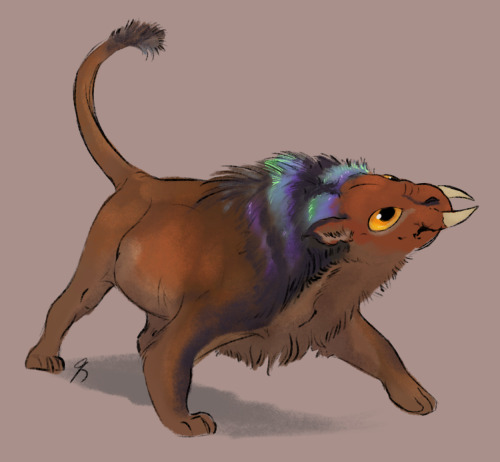
@silverhart-makes-art (link to post here) started with the thought that an example of an animal with strong jaws is an ant. But given the description of manes and fur, this is probably a mammal, so we get an "ant-lion" that they describe as looking "like he should be an alien pet in a sci-fi movie or game", which I think is spot-on. Good design for a weird alien pet. I really like the execution of the "ant's head but mammalian" concept, and the coloring of the mane looks really cool. Some more detail on design decisions can be found in the linked post.
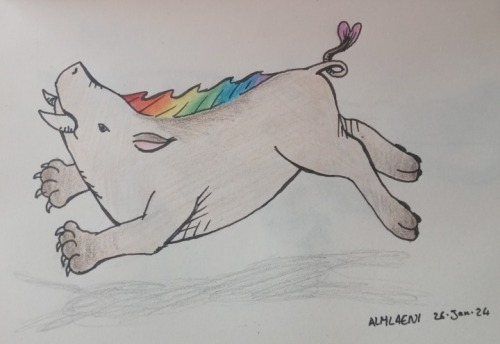
@sweetlyfez (link to post here) does note that she thinks she knows what this animal is -- but, in the spirit of the thing, intentionally avoided drawing that -- so we'll have to see how identifiable it is at the end of this post. She's also provided her own alt text, thanks for that. I find this design really charming -- the blend of porcine and feline makes for a good silhouette in my opinion, the pose looks cool, and the rainbow mane is quite pretty. I particularly like that the tuft of hair the entry says is a love charm is drawn to resemble a heart.
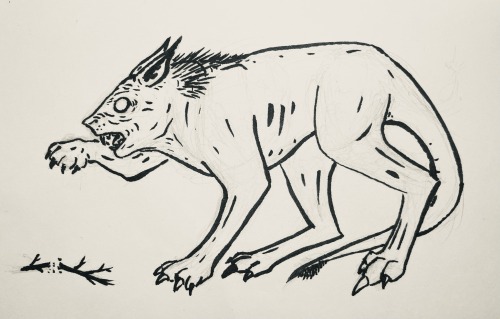
@cheapsweets (link to post here) has drawn a rather frightening-looking beast, here shown nipping its own paw after accidentally stepping on a twig. (They also provided alt text, thank you.) There's a lot of interesting design choices here -- explained in some detail in the linked post, check that out. We can see a stocky, muscular head and chest, showing that this animal has the strength in its jaws and chest mentioned by the entry, paired with kangaroo-like legs and tail to give it the leaping capabilities mentioned. Also, this picture shows an Ethiopian Almlaeni in summer, which is why it is bald except for a bit of fur on its mane and tail. The shining eyes, I think, are what really gives this animal an unsettling appearance.
Cheapsweets also would like to note that they're "on the lookout for some good resources for animal anatomy and musculature", so if anyone has any suggestions, please send those their way!
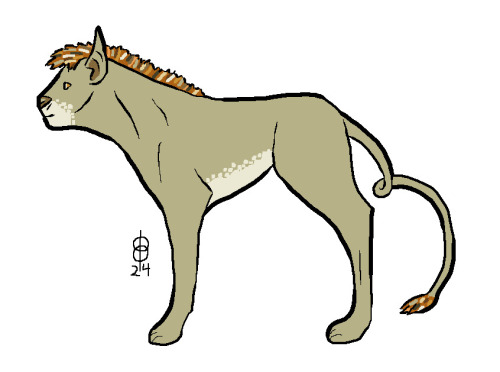
@pomrania (link to post here) has given us this creature that is very much A Mammal but it's hard to pin down anything more specific than that -- it makes me think of the sort of old engravings that archaeologists just kind of give up on categorizing as specific animals and end up just calling them something like "the [culture/location] Beast". It's kind of feline, kind of equine, and it has what Pomrania (accurately) characterizes as a greyhound-like build. This impression is aided by the pose and the line work -- I don't know, there's just something about it that makes me think "this should be on the wall of an old tomb somewhere." I like the vibe, is what I'm saying. Very good beast.
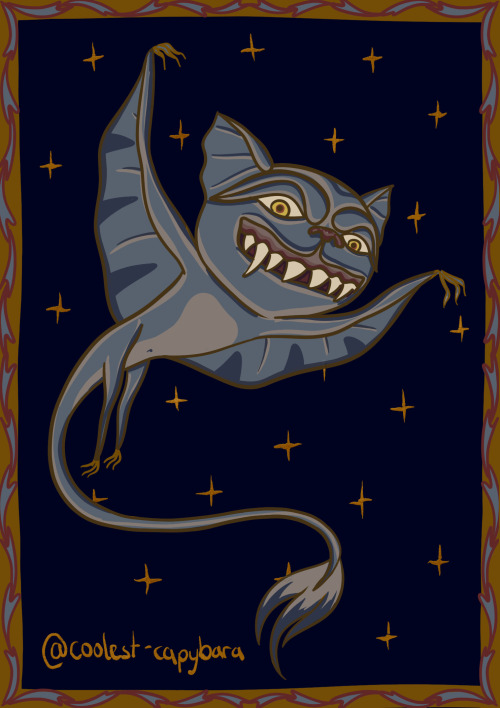
@coolest-capybara (link to post here) has selected a couple of the elements in the description that stand out and taken them to their most dramatic interpretation. The Almlaeni can jump in such a way that it seems to fly, and it can live on the wind -- what if it has bat-like wings it can glide on? (Someone else noted "live on the wind" as possibly suggesting flight depending on how you interpret the ambiguity of the phrase, but discarded the idea; here we're running with it.) The result is quite a fearsome beast; that face is downright scary. We can also see here sensory organs adapted to hunting at night, and strength concentrated in the front of its body (which probably helps with those wings). And of course the stylization is excellent as always -- the linework is very convincingly medieval and I swear I've seen illuminations with that exact style of starry background. The linked post describes the design decisions in a bit more detail. (Also thank you for providing your own alt text.)
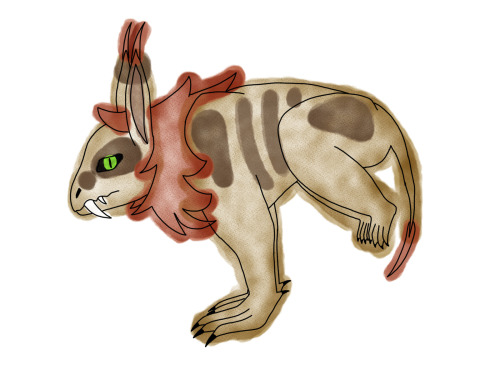
@strixcattus (link to post here) put this up after I drafted the rest of this post, and from the text of their post I think they guessed the nature of the animal, so take all references to it being more difficult to identify than I thought with a grain of salt. They also describe it as "a little freak (affectionate)" which is definitely an accurate description of the creature they've drawn. I really like the combination of different types of animal you can see here. The pose comes from a pretty reasonable interpretation of a couple points in the original entry: they can leap really well, but most of their strength is in the front half of their body. Therefore, obviously, they must use their front legs to jump and to propel themselves for rapid motion. Excellent direction to take that, I think. As usual, I strongly recommend clicking that above link and seeing the details Strixcattus writes up for their beasts.
And now, the Aberdeen Bestiary version.
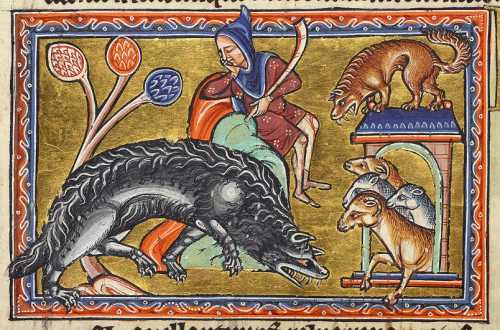
As you can probably gather from this image, this week's animal is the wolf. And I think it's an interesting peek into the medieval imagination to see how fierce that wolf looks. The shaggy fur, the fangs, the eyes -- it's striking. That looks like a fairy-tale illustrator decided to draw the Big Bad Wolf in such a way as to frighten children. All the best wishes to our heroic little dog up there.
I also like the interestingly-symbolic depiction of the sheepfold: it kind of looks like our sleeping shepherd keeps his flock in a TARDIS. And, of course, look at that lovely Stylized Tree in the background.
So yeah, it was the bit about them sneaking up on sheepfolds that I thought made it Too Obvious that the Almlaeni was a wolf. Glad that didn't turn out to be as much of a tip-off as I thought.
As for the Ethiopian wolves mentioned: damned if I know what they were thinking of. Jackals and African wild dogs can be pretty colorful, so there might be something there, but I wouldn't describe them as having manes. My best guess is that the original animal being described was a black-backed jackal, but it's hard to be sure what, if anything, the grain of truth is here. (There is an animal we call the "Ethiopian wolf", but it looks more like a coyote than anything, so I'm not seeing the "colorful mane" thing.)
The thing about this is that medieval authors were very much ignorant of that part of the world. "Ethiopia" to them was much like "India" -- to the modern ear, those are countries we're aware of with a defined location, and we can go read about them if we want. To medieval Europeans, both were just kind of vague geographical blobs: they knew these places existed because they heard about them from classical sources and/or from trading partners, but there was virtually no direct contact or reliable information. These were distant and mysterious lands to them, and as a result they were willing to believe just about anything regarding what those places were like. (Also, if you see "Ethiopia" in a medieval text, don't necessarily think the region we now call by that name -- it tends to just be an umbrella term for "sub-Saharan Africa".) So, leaping maned wolves? May or may not be based on anything real, and if it was, it's been Telephoned to death by this point.
a collection of motivational insights regarding content creation and creative hobbies






and of course the classic



Somehow, I had not twigged at all that this was referencing storks, but it seems so obvious from the description now it's been revealed!
And yes, the Crow Time comics are honestly delightful, and you should check them out if you haven's already!
Bestiaryposting Results: Blisheag
We've got another bird this week, but it looks like people are having fun with it, so let's see what came out of it.
As usual, if you're not sure what this is about, you can see previous material at https://maniculum.tumblr.com/bestiaryposting and follow stuff as it's posted at the tag maniculum bestiaryposting.
The entry our artists are working from this week can be seen here:
Roughly chronological order under the cut, &c. &c., you know how this works.

@silverhart-makes-art (link to post here) notes that the translation choosing to say "bill" instead of "beak" makes them think of ducks, and furthermore how that seems a bit odd that we have these two very similar terms, acknowledge that some birds have beaks and some have bills, and then don't really think about it. That's a pretty interesting point -- I'm tempted to take some time to look up whether there is a defined difference, but I have a post to write and other Tasks waiting in the wings, so please, if you know what that's about, let us know. The line that the Blisheag is an enemy to snakes naturally brought the secretary bird to mind, so here we see it trampling a snake with its talons. (Some of our other artists also made the connection to secretary birds and their practice of stomping snakes -- it's interesting to me that this is apparently a part of Tumblr's collective consciousness.) Also, the coloration is based on the American black duck, which Silverhart describes as "quite a handsome duck", and I have to say the color pattern is pretty nice.

@sweetlyfez (link to post here) has also gone for large talons for stomping snakes, and in the absence of any specific physical details, decided to have some fun with it. I like the choice to give it a turkey-like body and tail combined with a long neck like a flamingo. Sweetlyfez also included the detail in the entry that the Blisheag loses its feathers while diligently incubating its nest, giving it a bald neck and head. I think the effect is kind of charming -- it kind of evokes a flamingo, but since that's bald skin rather than pink feathers, it would probably look closer to a vulture in person.

@cheapsweets (link to post here) has given us a whole group (they helpfully inform us that the collective noun is a "lance") of Blisheags attentively listening to a crow who is perched on a stump. I really like this interpretation of them following crows as guides -- like it's not just an instinctive behavior but they're actively in collaboration with the crows somehow and take verbal direction from them. Something really clever here that's easy to miss if you don't know what you're looking for -- which is why you should make a practice of reading Cheapsweets's linked posts, as they tend to include detailed explanations -- is how they've interpreted the details that describe the Blisheags making creaking & clashing noises and following the crows like an army. Look at those varied head shapes on the different Blisheag subspecies: they're patterned after different styles of knights' helmets. Also, I'd like to thank Cheapsweets for providing their own alt text, and acknowledge that I of course noticed the Stylized Trees.

@coolest-capybara (link to post here) has as usual done some delightful medieval stylization in this week's art. (And provided their own alt text, thank you.) Something I think is really clever here is how she's interpreted "enemies of snakes" as combined with "fly across the sea" -- obviously, when they're migrating, they have to deal with being menaced by sea serpents. Brilliant. As for the actual birds, we see them following crows of course, and apparently in the absence of physical description, Coolest-capybara decided to pattern them after a depiction of a bird in an old church window; if you want to see the window, you should check out the linked post. It's a good bird design, I think.

@pomrania (link to post here) also thought "secretary bird" and decided to run with it. They mention going a bit Seussian in design, and I think it really works. (Also apparently the crow is patterned after the "Crow Time" comics, which Cheapsweets also namechecked, so I suppose I should go look at those at some point.) Aside from the delightfully whimsical look of the bird in general, I think the really clever part of the design is those little round bumps on the end of its beak. They also noted the description of the Blisheag making noise by clashing its bill, and decided to give it a bill that's adapted to making noise -- they describe it as a "roseate spoonbill crossed with a tambourine". I love it.

@strixcattus (link to post here) notes the lack of specific detail but has drawn this ibis-esque bird with a very good curved beak. The gold here is in the description Strixcattus provides to remedy the "lack of detail" problem, which includes more on the nesting practices alluded to in the entry and an explanation of how it hunts snakes -- since, of course, it is the enemy of snakes, as we know. Again, you need to go read all of the worldbuilding naturalist posts Strixcattus has done for this exercise; they're delightful and very well thought out. Also, I think this drawing is the closest to the real bird, so let's go ahead and transition to...
... the Aberdeen Bestiary version. (Note: this time around I straight-up forgot what bird this was supposed to be when I sat down to do this post, but luckily I made a spreadsheet back when I started this that I was able to reference.)

Yep, those are definitely storks. Pretty recognizable depiction, I'd say. Frog looks oddly happy with being caught here.
The migration habits of storks are actually something that comes up in other medieval texts. Pretty sure they're just guessing with "Asia" here; medieval Europeans didn't really know where storks went. The version I like best is in the tradition that includes the Old English Wonders of the East, wherein we are informed that storks are only birds when they summer in Europe -- when they're back home for the winter, they take humanoid form. Really. The text in the Wonders of the East is as follows (translation mine):
There are men born who are 15 feet tall, & they have white bodies & two noses on one head. Their knees are very red, their noses long, and their hair black. When they wish to give birth, they travel on ships to India, and there bring their kin into the world.
Doesn't sound like it's talking about storks? There's a reason for that. The Wonders of the East is actually a great example of Manuscript Telephone. Ann Elizabeth Knock, in her dissertation "Wonders of the East: a synoptic edition of the Letter of Pharasmanes and the Old English and Old Picard translations" (which you can get a PDF version of at this link here), gives us the following view of the original version:
Men are born there with long legs. They are very tall, 12 or 15 feet. They [or, in some versions, just their arms] are white. Their faces are divided. They have red feet. The head is round; they have long noses and black shoulders. At a certain time, they transform into birds. As birds, they breed in [an area familiar to the reader of the Letter]; you call them storks.
The Wonders of the East lost the stork aspect in transmission -- the next entry in the Wonders starts with "There is a land in Gaul called Ciconia", which is the end of the above version being accidentally attached to the next bit and reinterpreted. Ciconia is Latin for "stork", and the version the scribe was copying from probably named Gaul as the area where they went to breed.
(Similarly, traveling on ships in the Wonders of the East is probably a confusion of navis 'ship' and avis 'bird'.)
For more on the Wonders of the East, we did a three-part episode on it back in March 2021, and I later wrote up a summary of the differences between the text we used and Knock's reconstructions at this link here. (Very much summarized, Knock's work is lengthy & detailed & a surprisingly good read for an absolute doorstopper of a dissertation.)
“I have given up attacking other knights for Lent…”
i entirely get why people are like "actually knights were historically land-owning nobles waging war on people" and reminding people that idealised modern conceptions of knights are not historically accurate, it's just really really funny given that people have been idealising the institution of knighthood since like. the twelfth century or earlier, go take it up with fucking chrétien de troyes

